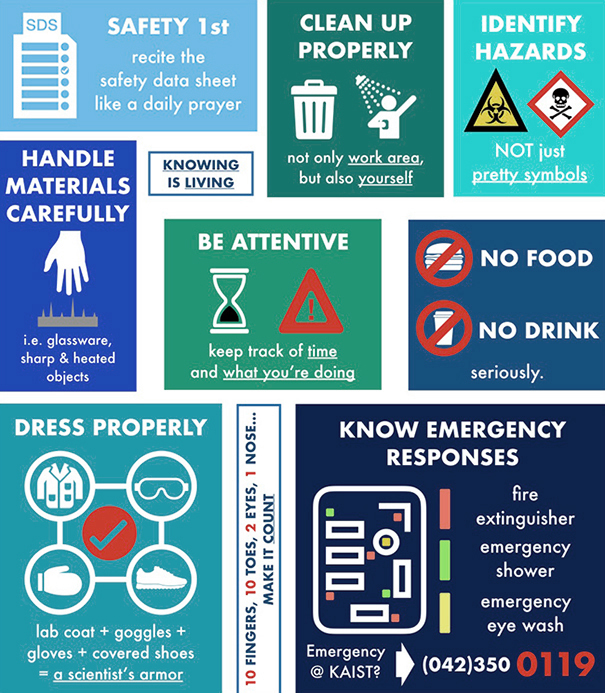Safety
MSE members aim to
continuously monitor the overall safety management of laboratories and prevent accidents. Faculty, staff, researchers and students should be alert to the hazards associated with chemicals used in their research.
Safety Rules in the Laboratory

DMSE offers Safety Binder to provide safety instructions and responds to emergency situations in all laboratories.
For additional assistance you can get information below.
- 042-350-0119 (Dial 0119 on Campus)
* Call Campus Police in case of Injury, Fire or Hazardous leakage.(24/7)
Emergency Response Tips for Each Laboratory Accident Type
- Fire Accident
- Gas Leakage
- Chemical Leakage
- Biological Hazard Leakage
- Machine Accident
- Earthquakes
Fire Accident
- Activate fire alarm
- Extinguish the fire with the fire extinguisher, the fire hydrant
- Evacuate the building by informing the respondent of the unique situation in the laboratory.
※ Do not use the elevator.
- Report to 119 or KAIST Emergency Control Office when your safety is secured.
- When locked inside, seal the window and door by using wet blanket or towel. Then cover the nose/mouth with wet towel, lower the posture
Gas Leakage
- Check the alarm of the gas leak detection device installed in the lab receiver. Must Confirms the type and amount of leaked gas.
- When inflammable gas had leaked, shut off the gas valve and ventilate the laboratory.
- If toxic gas had leaked, immediately evacuate out of the building with the laboratory colleagues.
- Report to KAIST Emergency Control Office(includes location of leakage, amount and the type of leaked gas)
- Wear personal protective equipment (gas mask) in case of toxic gas leakage.
- In case toxic gas is inhaled, move to get fresh air and seek help of a specialist.
Chemical Leakage
- Wash the exposed body part with clean water for more than 15 minutes.
- If the chemical got on the clothes, take it off while you washing the area with flowing water.
※ When you contact with solid power, shower after shaking it off. Do not wash with water in case of water-reactive chemical
※ In case of skin contact with hydrofluoric acid, sufficiently washed out the area thoroughly with water and apply calcium gluconate gel on the skin. - Wear personal protective equipment (gas mask) when hazardous gases are generated.
- Prevent further leakage by forming chemical sorbents, chemical absorbent booms.
- If you are unable to make any treatment, isolate the spill area and evacuate.
- Report to KAIST Emergency Control Office and inform the occupiers to evacuate
Biological Hazard Leakage
- Wash the exposed body part with clean water for more than 15 minutes.
※ If the biological hazards got on the clothes, take it off while you washing the area with flowing water.
- If biological hazard leaks, isolate spill area and report to KAIST Disaster Prevention Center
- When an animal escapes, use the fence to block the animal escape route and the net to catch it.
※ Never touch the escaped animal with bare hands.
- Disinfect the exposed area and disposal contaminated animals with medical waste.
Machine Accident
- Immediately stop the machine in case of an accident.
- Wrap the wound with a thick cloth or gauze to stop the bleeding.
- Seek help from 119 or KAIST Emergency Control Office according to the patient's condition.
- Wash the severed body part, wrap it with plastic, keep it in an ice pack, and deliver it to 119.
Earthquakes
- The time of the earthquake shaking greatly is within 1 or 2 minutes.
- When the vibration starts, go under the table to avoid the body or protect your head with a cushion.
- Evacuate to a large space outside after a large vibration stops
※ Use emergency stairs and do not use elevators.
- Report any injury to KAIST Disaster Prevention Center
- Wait outside until granting access in building.







